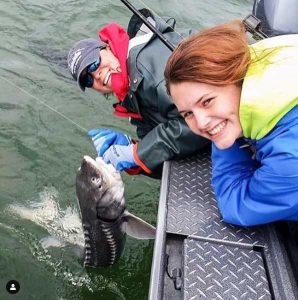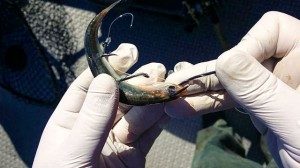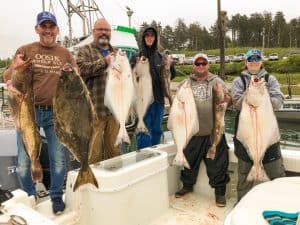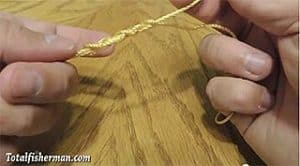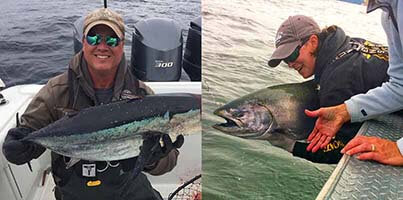Check out our Astoria Fishing Charters and Washington Halibut Charters

Photos courtesy of Flickr & Cor23
The record 2009 summer steelhead return to Idaho and northeast Oregon streams has continued unabated into a new year that also may see the biggest upriver spring chinook salmon run in modern times.
“We’ve had a record harvest (more than 50,000 steelhead) and a record number of angler days,” Ed Schriever of the Idaho Department of Fish and Game told the Northwest Power and Conservation Council Wednesday. Schriever, chief of the IDFG’s Fish Division, and Bill Tweit of the Washington Department of Fish and Wildlife on Tuesday in Portland briefed the Council about 2009 salmon and steelhead returns to the Columbia-Snake river basin and the high expectations for some 2010 returns.
The steelhead record is still building. Schriever noted that steelhead continue to pass up and over Lower Granite Dam, the last of eight hydro projects that the fish swim towards tributary spawning grounds and hatcheries. During the first week of March counts at the dam ranged from 46 to 213. The IDFG’s steelhead “year” runs from April 1 through March 31.
A total of 312,430 summer steelhead were counted at Lower Granite Dam between April 1 and the end of 2009. That number was double the 10-year average and easily broke the modern-day record — 268,466 fish counted in 2001-2002. And the counting goes on. During the previous 8 years from 8,000 to 16,000 steelhead annually have passed Lower Granite between Jan. 1 and April 1 according IDFG estimates.
All Idaho steelhead, and those bound for Oregon tributaries to the Snake above Lower Granite, are summer steelhead, which means they leave the ocean in the late summer. The bulk of these fish arrive in Idaho by early fall. They will then spend the winter in the Snake, Salmon and Clearwater rivers in Idaho and Imnaha and Grande Ronde in Oregon, and spawn the following spring.
Fish managers have broadly grouped the upriver summer steelhead into two types, A-run, and B- run. A-run steelhead, which return to tributaries throughout the Columbia and Snake basins typically spend one year in the ocean, returning as 5- to 10-pound adults. B-run fish originate primarily from Idaho’s Clearwater River, and typically spend two to three years in the ocean, returning as 10 to 20 pound adults.
A-run fish made up the vast majority of the 2009-2010 Snake River summer steelhead return. Estimates are that the B-run numbers would be about half of the previous 10-year’s average of 30,000 fish.
By late December, steelhead are distributed throughout the central Idaho region in the Clearwater from Lewiston upstream to Kooskia, the Snake upstream to Hell’s Canyon Dam, and throughout the Salmon River. The fish can also be found in the Grande Ronde and Imnaha river basins in Oregon.
During the week ending March 7 Idaho anglers caught and kept 472 steelhead and caught and released 740.
And steelhead fishing continues to be good in the Grande Ronde and Imnaha basins. Catch rates (hours per steelhead landed) in last week’s creel surveys were 6.8 for the lower Grande Ronde, 7.7 for the Wallowa River Canyon, 2.1 for the Rondowa area, and 1.3 for the Imnaha River, according to the Oregon Department of Fish and Wildlife.
Steelhead angling conditions will depend on weather and flow conditions and anglers should check river flows.
The bag limit on the lower Grande Ronde, Wallowa, and Imnaha Rivers and Big Sheep Creek in Oregon is five adipose fin-clipped steelhead per day. Anglers are encouraged to keep adipose fin-clipped hatchery steelhead that they catch and take advantage of the expanded bag limit.
Likewise the daily bag limit in Idaho was raised because of the season’s very large A-run (with the stipulation that only three can be greater than 32 inches in length) on the Snake, Salmon and Little Salmon rivers. The reason for the 32-inch rule is that most B-run steelhead are longer than 32 inches.
On the Clearwater, the limit will remained unchanged at three per day for the spring season which began Jan. 1. The statewide season limit has also been raised to 40 fish for the fall 2009 season, with the stipulation that only 20 of those fish can come from the Clearwater.
A forecast for the 2010-2011 upriver summer steelhead return has not yet been completed.
Another 2009 record breaker was a Lower Granite count of 1,219 Snake River sockeye salmon. That bettered a total of 909 in 2008, which improved on the 257-fish total in 2000 which had been the biggest since the counts at the dam began in 1975. Over the 14 years prior to 2000, a total of just 77 natural-origin sockeye returned.
The Snake River sockeye were listed under the Endangered Species Act as endangered in 1991. The Snake River Sockeye Salmon Captive Broodstock Program was initiated just before the listing in 1991 to conserve and rebuild the Redfish Lake sockeye salmon stock in the Sawtooth Valley of central Idaho. Most of the returns now have their origins in the program.
The IDFG is expecting another bumper crop of sockeye this year, Schriever told the Council. Its estimate is for a return of from 700 to 1,100 adult fish.
The record breaker this year is expected to the upriver spring chinook salmon stock, which has as its largest component the Snake River spring/summer chinook.
The overall upriver spring chinook prediction is for a return of 470,000 adult fish to the mouth of the Columbia River, according to U.S. v Oregon’s Technical Advisory Committee, which is made up of federal, state and tribal fishery officials. Last year the forecast was for a return of 298,900; the actual return was 169,300.
TAC expects the Upper Columbia spring chinook stock, which is part of the upriver run, to number 57,300 adults this year, including 5,700 that were born in the wild. The Upper Columbia forecast in 2009 was for a return of 23,1000 adults, including 2,700 wild fish. The actual return was 17,400, including 1,800 wild.
TAC predicts that the Snake River component of this year’s run could total 272,000, including 73,400 spawners of natural origin, again as counted at the Columbia mouth. Last year the forecast was for a return of 179,200 adult fish, include 29,700 wild chinook. The actual return was 92,000, including 20,300 wild fish.
This year the IDFG is predicting that as many as 179,000 Snake River spring/summer chinook spawners, including 28,500 wild fish, will make it as far upstream as Lower Granite.
“We are holding our breath,” Schriever said of the excitement at the prospect of a large spring run. “179,000 across Granite would be a record. That’s a very robust return.”
The 2010 return of salmon and steelhead to the Columbia and Snake river basins could total 2.2 million for the second consecutive year, Tweit said. Such a total would have been unheard of during the 1990s but during the most recent decade various populations have experienced growth spurts stemming from freshwater survival improvements that have been gained and, in spurts, positive growing conditions in the Pacific Ocean.
In addition to the expected record spring chinook run, forecasts are for strong summer chinook, sockeye and fall chinook runs and “average” upriver steelhead and coho runs in 2010.
More than 1 million coho returned last year but only 390,000 are expected this year.
“They are the first indicator” of a shift in ocean productivity, Tweit said of the coho, which, for the most part spend only one year in the ocean. Ocean conditions took a turn for the worse last year.
The most recent decade has shown greatly improved numbers over the 1990s, Schriever said. For Snake River spring/summer chinook, Lower Granite counts averaged 6,000 wild spawners and 10,000 hatchery returns from 1990-1999. Those numbers jumped to 19,000 wild and 52,000 hatchery fish from 2000 through 2009.
The steelhead counts climbed form 10,700 wild and 67,000 hatchery returns on average annually from 1990 through 1999 to 26,200 wild and 161,000 hatchery returns on average during the most recent 10-year period. For fall chinook counts rose from 1,300 annually to 11,000 and for sockeye the average went from 10-fish per year in 1990-1999 to 273 in 2000-2009.
